1982 Belgian Grand Prix race report
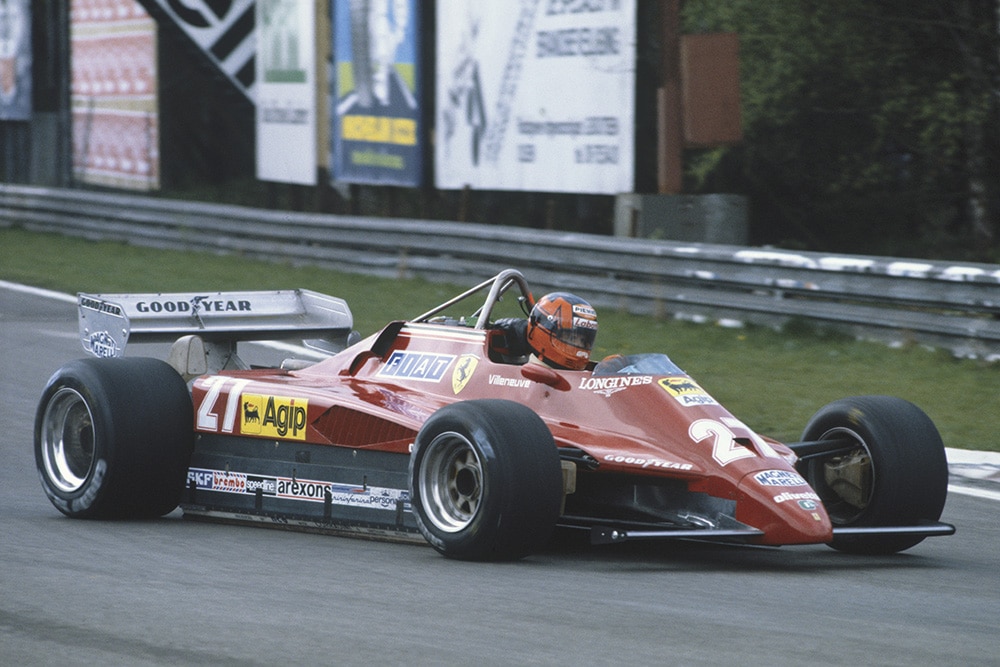
Gilles Villeneuve was tragically killed in practice after crashing his Ferrari
Motorsport Images
— An air of foreboding
Zolder, May 9th
WITH the Imola “strikers” returned to the lucrative world of Formula One, the Belgian entry was full to overflowing, but their union shop-steward made it clear that he and his men intended to employ “disruptive methods” and protest against anything and everything. Consequently, although the entire entry was ready to go on Friday morning a lot of people were looking over their shoulders wondering what the FOCA “special-builders” would get up to.
The absurdly crowded conditions in the Zolder circuit pit lane have at last been dealt with and it is a pity that we had to wait until the death of the Osella mechanic last year for any serious action to be taken. A total rebuild of the pit and paddock area was completed well on time and full marks to the organisation for the way it was carried out. With 32 drivers in the line up there had to be some sorting out before the Friday afternoon qualifying session and this was done according to the Concorde Agreement, one of the rules nobody has found fault with yet. During the Friday morning test-session lap times were taken for Boesel (March), Jarier and Paletti (Osella), Warwick and Fabi (Toleman) and Villota (March) and the two slowest were destined to become spectators.
Qualifying
The remaining four could join in the rest of practice on an equal footing with the graded-team drivers to try and get in the select 26 that would actually start the race. Among those assured of full practice, thanks to their team scoring points in the Manufacturers Championship last year, there were a few changes. The courageous Swiss driver Marc Surer was back with the Arrows team, fully recovered from his crash while testing at Kyalami in January, Brian Henton was continuing as number two in the Tyrrell team, having “negotiated” Slim Borgudd out of the way, Jan Lammers was being given a drive in the Theodore, Emilio de Villota financed himself into a third March car, but most important of all Derek Daly was making his debut as number two in the Williams team, Reutemann having retired and Andretti unwilling to break his American track-racing contract. From almost being out of work last October Keijo Rosberg was now number one in the Williams team that won the Manufacturers Championship last year.
The Williams and Brabham teams were at one end of the long row of new pits and Renault and Toleman were at the other, with the rest scattered in between. Williams were ready to go with three FW08 models making their first public appearance, Daly actually having a brand new car, while the Brabham team had a trio of sleek BT50 cars, powered by turbocharged BMW four-cylinder engines. One thing was certain and that was that Ecclestone was not going to make any fatuous protest about the use of turbines (see the Imola report). It was rather cold and grey, which did not help the atmosphere of foreboding, but at least it was dry and due to a shortage of doctors on duty Professor Watkins held up the start of practice for 21 minutes (see Motor Sport May 1982). When practice got under way Daly did one lap in the new Williams and stopped for the mechanics to check that all the systems were functioning correctly on the new car, but Rosberg was not happy with the brakes on his car and changed over to the spare car. With this car (FW08/3) he was soon setting the pace and fully justifying his promotion to team leader, both Williams cars running with full water tanks to keep them legal. In the next pit Piquet and Patrese were nothing like so happy, for while the turbocharged BMW was producing a lot of power its pick-up was far from clean and the coughs and bangs just as they wanted full power out of a corner must have been very frustrating. After the smooth flexibility of Cosworth power, the Munich engine was keeping the drivers very busy.
At the other end of the pits, Arnoux was going well in his Renault turbo and vying with Rosberg for the best lap time, not that it counted for anything but it was a good morale booster. On the other hand, Frost was having a bad time with an overheating engine and he switched to the spare car, and before the session was over Laffite zoomed out of the paddock in the spare Talbot-Matra V12, unhappy with the way his own car was performing. The narrow-bodied Alfa Romeo 182B (see notes on the cars) had done no running before it arrived at Zolder so Giacomelli’s laps were very much in the nature of a test-run and the car was soon put to one side in favour of the normal Tipo 182, which was a self-explanatory move. The Ferrari team were not happy with the selection of tyres offered them by Goodyear and were not really in the running, but some juggling about with compounds and things made a bit of improvement, though lack of adhesion on full power acceleration was the main problem. The ATS team were on Michelin tyres which did not necessarily improve their performance but at least it got them out of Ecclestone’s clutches.
When it was all over the “rabbits” were sorted out and Paletti (Osella) and Villota (March) were left out of the list of runners for the afternoon hour of qualifying. Tyre choice having been made by everyone two sets were marked with the driver’s number, these markings to be checked by marshals before each car left the pit lane. A word of warning went round that any car might be called upon to be weighed at any time, and anyway the two fastest cars at the end of the qualifying hour, plus two more drawn from a hat would be weighed when it was all over.
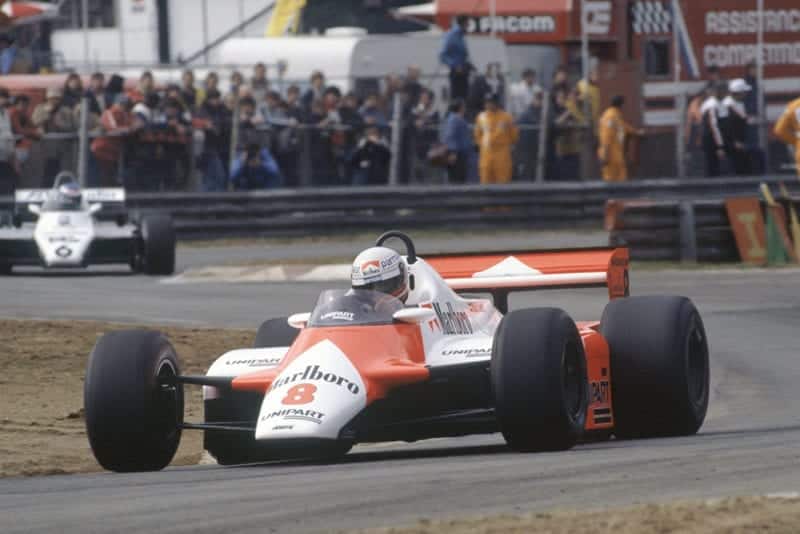
Niki Lauda in his McLaren MP4/1B-Ford Cosworth leads Keke Rosberg in a Williams FW08-Ford Cosworth).
Motorsport Images
Shortly before the end of the morning session Pironi’s Ferrari died out on the circuit and had to be towed in afterwards and no sooner was this done than the rain started, and for a short while it pelted down. In matter of minutes the sun came out and everything dried very rapidly, including the track, though it was still a bit damp in places when the qualifying hour was due to start, 21 minutes later than specified, due to the morning delay, which was just as well as every minute meant a drier track. Rosberg had settled for FW08/3 so FW08/1 became the T-car and during the interval Pironi’s Ferrari engine was checked over and a new waste-gate boost-valve unit was fitted. Prost’s Renault was going to need an engine change so he stayed with the spare car and Pironi did not do many laps in his own Ferrari before he abandoned it and took over the spare car (057). Rosberg’s car was still not right in the braking department so he switched back to the number 1 car and Patrese’s qualifying stopped when his turbocharger unit gave trouble. While he remained seated in the cockpit Brabham mechanics changed the whole unit, including the four-branch exhaust manifold, which was a slick bit of work even though a few fingers got burnt. For a long while all those vying for the front of the grid were lapping around the 1 m.. 17 sec. mark, two seconds faster than the previous best which dated back to 1980 and among those in the running were the two Renault drivers, Rosberg, Piquet, Lauda, Alboreto, Villeneuve and Mansell. Suddenly everyone staggered back disbelief as first Prost and Arnoux got below 1 min. 16 sec. Frost did 1 min. 15.962 sec. and Arnoux did 1 min. 15.903 sec. when everyone else was flat out to break 1 m. 17 sec., the nearest being Piquet with the turbocharged BMW-powered Brabham with 1 min. 17.124 sec. A junior engineer in the Williams team was heard to suggest that Renault must have been using illegal fuel in their engines. A remark typical of the mentality of the British “special-builders”, with no thought for the ELF company who supply the fuel for Renault. All this rather overshadowed the very fine effort of Michele Alboreto, fresh from his third place in the San Marino GP. He quietly gets on with the business of being a racing driver, while others are busy explaining why they are not World Champion, or why they are not on pole position. All morning Tyrrell number three had been well up the list of unofficial times, and now that it really mattered Alboreto was in fourth place, ahead of all the other Cosworth-powered teams like Williams, McLaren, Lotus, and Arrows as well as the Ferrari duo, both Alfa Romeos and both Talbot-Matra V12 cars. It was all done without hysterics or heroics, but if you watched him out on the circuit you could not fail to notice the way he powered through the corners, to exit much faster than most, especially on corners that led on to straight sections of the circuit. Added to that was a notable smoothness in his driving and he looked relaxed and safe at all times.
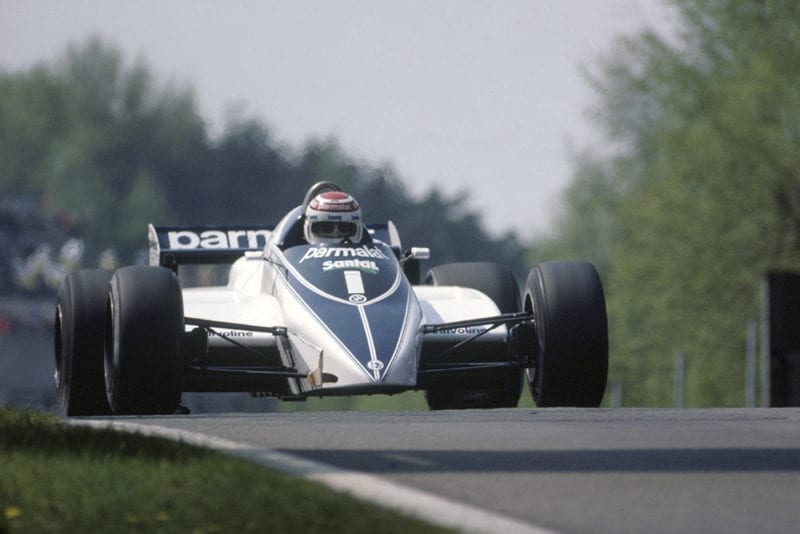
Nelson Piquet at the wheel of a Brabham BT50-BMW.
Motorsport Images
With turbocharged cars in the first three places we awaited the shop-steward to apply his disruption, but nothing happened, though the two Renaults, Guerrero’s Ensign and Henton’s Tyrrell were taken away to be drained of fuel and weighed. The result was Renault (Arnoux) 581 kgs. Renault (Prost) 592 kgs. Ensign (Guerrero) 594 kgs and Tyrrell (Henton) 577 kgs. Three kilogrammes under the weight limit meant that Renton was disqualified and his times were scrubbed from the resultsat being that we went home to tea.
Saturday morning was dry but there were still some damp patches on the track from overnight rain and the air was positively cold. Everyone was out “testing”, which usually means juggling with all the variables of tyres and aerodynamic configurations to try and hit on a compromise that was acceptable. Giacomelli only did a lap or two in his Alfa Romeo 182 before he stopped and complained of back ache, and was forced to go and lie down, leaving de Cesaris to do all the running for the Autodelta team. Rosberg was still very quick, but he looked to be on the verge of disaster round some of the corners, obviously taking a lot out of the car and its tyres. Patrese had to take to the spare Brabham when his BMW engine blew up and de Angelis was out in the spare Lotus. As things were measured, temperatures taken, consumptions of liquids calculated the morning passed off without undue incident and even though the Zolder circuit is notoriously hard on brakes, Ferodo and AP-Lockheed seemed to have it all well under control, though many cars needed to sport extra ducts to scoop air into the brake discs. Such was the eagerness behind this test-session that some drivers put in an enormous number of laps. Rosberg managed 33 timed laps, Prost 32, Arnoux 31 and Mansell 30, which does not take into account single laps on which a time was not recorded. At the other end of the scale Winkelhock managed only four laps before things went wrong with his ATS.
The final hour for qualifying for the starting grid took place under cool and grey skies, but it remained dry thankfully, and the battle began to try and catch the Renaults, as far as the fast runners were concerned, while the slower ones down at the back merely tried as hard as they could to avoid being “tail-end Charlie”. The new Williams cars were not entirely satisfactory in the braking department and to add to the troubles the engine in Daly’s can blew up and he had to qualify in the T-car. The BMW engines were also far from perfect, both drivers having trouble, but the McLarens and Tyrrells were going well. Lauda was ever to the fore, making it more and more difficult to believe that he has been away for two years, and making one wonder what some of the others have been doing in the meantime. Alboreto was right up there with him and his consistency during all four practice sessions was remarkable, but Henton could not get near him, though the Derby man soon put in a time that guaranteed him a start, having forfeited his Friday times. Both Renault drivers went even quicker than before, with very little to choose between them, but somehow when you watched them out on the circuit Prost looked that bit better than his team-mate. Rosberg was putting all he knew into his driving of the new Williams and was rewarded with a fine lap in 1 min. 15.847 sec., faster than the times set by the Renault team the day before, but not as fast as they had gone in this second session. Nonetheless, Rosberg retained the distinction of being the only driver to get below 1 min. 116 sec., apart from the Renault drivers.

Alain Prost took pole for Renault
Motorsport Images
The final hour for qualifying for the starting grid took place under cool and grey skies, but it remained dry thankfully, and the battle began to try and catch the Renaults, as far as the fast runners were concerned, while the slower ones down at the back merely tried as hard as they could to avoid being “tail-end Charlie”. The new Williams cars were not entirely satisfactory in the braking department and to add to the troubles the engine in Daly’s can blew up and he had to qualify in the T-car. The BMW engines were also far from perfect, both drivers having trouble, but the McLarens and Tyrrells were going well. Lauda was ever to the fore, making it more and more difficult to believe that he has been away for two years, and making one wonder what some of the others have been doing in the meantime. Alboreto was right up there with him and his consistency during all four practice sessions was remarkable, but Henton could not get near him, though the Derby man soon put in a time that guaranteed him a start, having forfeited his Friday times. Both Renault drivers went even quicker than before, with very little to choose between them, but somehow when you watched them out on the circuit Prost looked that bit better than his team-mate. Rosberg was putting all he knew into his driving of the new Williams and was rewarded with a fine lap in 1 min. 15.847 sec., faster than the times set by the Renault team the day before, but not as fast as they had gone in this second session. Nonetheless, Rosberg retained the distinction of being the only driver to get below 1 min. 116 sec., apart from the Renault drivers.
With 30 cars out on the track, or in the pit lane the “traffic” was very heavy for the fast drivers and it was sheer luck if any of them got a clear run when trying for a fast time. With the silly limitation of only two sets of tyres to use up there was a fair degree of frustration among those at the top of the grid. With only eight minutes of qualifying left, the Belgian announcer nearly suffered a seizure. He had seen an horrific crash on his TV-video screen from the far side of the circuit and he became so hysterical that it was sickening. Without doubt a Ferrari had crashed very badly and as Pironi was in the pit lane it had to be Villeneuve. He was in the middle of a last desperate bid to improve his grid position when he came upon Jochen Mass going a lot slower. The Ferrari left-front tyre just clipped the right rear tyre of the March and launched it up into the air, to somersault and crash nose first into the ground still travelling forwards at upwards of 140 m.p.h. The front of the Ferrari broke off completely and wreckage scattered across the track. Practice was stopped and the unfortunate Canadian was flown by helicopter to the nearby Louvain hospital where doctors put him on a life support system to try and recover him, but it was to no avail and in the evening his death was announced officially.
Eventually the remaining eight minutes of qualifying was played out but only a few drivers went out, notably the two Brabham-BMW drivers, who desperately needed to improve their times, and some of the “rabbits” who were still among the non-qualifiers. As it turned out no improvements were made and practice ended on a sad and grey note. People who arrived from England on Saturday evening assured us that lovely weather was on its way from home, and they were right for Sunday was warm and sunny with clear blue skies. However, even this could not detract from the greyness of the day before and the space where the Ferrari transporter had been added poignancy to the tragedy. In respect to their number one driver, the Maranello team withdrew their second car and returned to Italy, to grieve the loss with the rest of the racing world. The two Ferraris had been due to line up on the grid, one behind the other on the right-hand side, and rather than leave this big gap everyone agreed that the field should close up two places and Mass and Baldi should be allowed to join the back of the grid. Left out were Guerrero (Ensign) and Lammers (Theodore) both drivers hampered by not having a spare car to use when hey had trouble. The Columbian driver of the Ensign had qualified well on Friday, in 19th position, but on Saturday clutch trouble held him up for a long time and he only got two timed laps in, and everyone else improved so much that his Friday time was not good enough.
Race
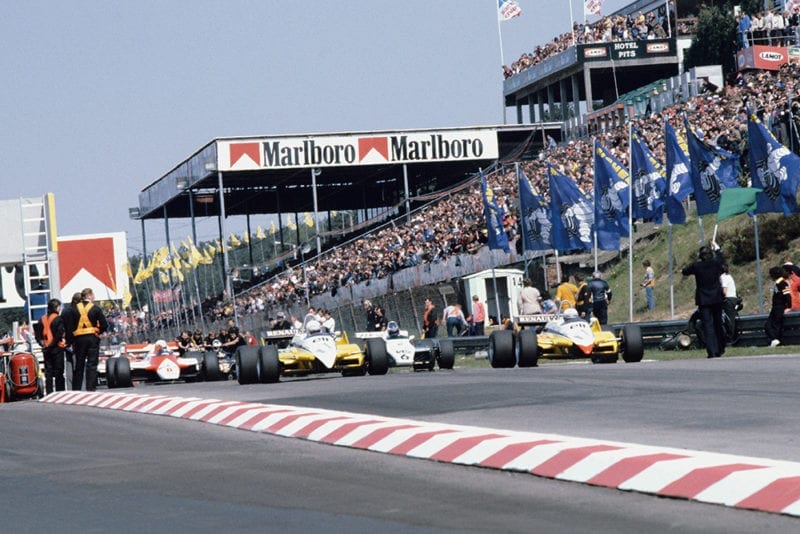
Rene Arnoux leads as the lights go out
Motorsport Images
The half-hour warm-up session at midday did not go as smoothly as usual, for Rosberg’s Williams had a misfire at high r.p.m and as no reason could be found a hurried engine change was started. At the other end of the pits the Renault team were busy changing the turbocharger units on Prost’s car, as one had failed during the half-hour and they were taking no chances. Cheever’s Talbot-Matra was forced in as the young American had spun off into the sandy run-off area, but no damage was done. The start was due at 3.30 p.m., with the pit-lane opening 20 min. beforehand, to allow two laps before lining up on the dummy-grid, though it meant passing through the pit-lane to take advantage of the concession. Prost, Daly, Rosberg, Warwick, Laffite, Salazar, Patrese and Winkelhock all took advantage of a second lap and well on time the 16 starters were lined up in front of the pits with the two Renaults at the head of the two rows, with Prost on pole-position, his car having a dayglow orange point to the nose for recognition purposes. Quietly pleased were the Toleman-Hart team as both Warwick and Fabi had qualified comfortably for the grid and well satisfied was Marc Surer who qualified his Arrows as it was his first race this year, having crashed prior to the South African GP.
The whole field went round on the parade lap, but while doing so Mansell’s clutch operation failed and he could not make it disengage so he free-wheeled up to his position on the starting grid, hoping to snatch it into gear at the start. When the green light glowed Arnoux made the best getaway and led off to start the 70-lap race, but Prost fluffed his start and Rosberg nipped ahead of him. Behind them Mansell stalled his engine on the Lotus 91 and remained motionless while those behind him swerved past using the middle of the track. Giacomelli arrived at speed from the back of the grid, swerved into the middle as Laffite was alongside him, which forced the Talbot-Matra over to the right where Salazar in his ATS was minding his own business. The right front wheel of the Talbot hooked the left rear of the ATS and put it into a slide, heading across the track to he left and it promptly cannoned into the passing Alfa Romeo of Giacomelli. Both cars slid off into the barriers as the others went on their way, leaving the stationary Mansell to be push-started by his mechanics. At the back of the grid Warwick had stalled his Hart engine and was push-started by marshals. Winkelhock’s ATS expired on the opening lap with clutch failure, so with the race only just begun we were down to 21 runners in a pack, two already a long way behind and three already out of the race.
It took only three laps for the 21 to divide into groups, with Arnoux setting the pace with Rosberg hanging on like a terrier. Then came Prost, Lauda and de Cesaris nose to tail and it was clear that the Renault was not on form and was holding up the McLaren and Alfa Romeo. The remainder were being led comfortably by Alboreto, the two Brabham-BMWs being right behind him, followed by Watson, Daly, de Angelis, Jarier, Cheever, Henton and the rest, with Mansell already catching the tail enders and Warwick ploughing a lonely furrow on his own at the back. Just as we were wondering how long Rosberg could hang on, the leading Renault faltered out of the hairpin at the far end of the circuit and headed for the pit-lane while the Williams sailed on into the lead, the new FW08 leading its first race. One bank of cylinders on the V6 Renault had gone rough and was not producing power. This was on lap five and behind there had already been gloom in the Renault pit for on the previous lap Lauda and de Angelis had overtaken Prost, his Renault not handling consistently, doing one thing on left hand corners and the opposite thing on right-handers, but he was still ahead of Alboreto, though the curly haired young Italian was under pressure from the Brabham-BMW of his surly compatriot Riccardo Patrese who was ahead of World Champion Nelson Piquet. Behind them came the Irish contingent, John Watson ahead of Derek Daly, but both a long way away from the leader.
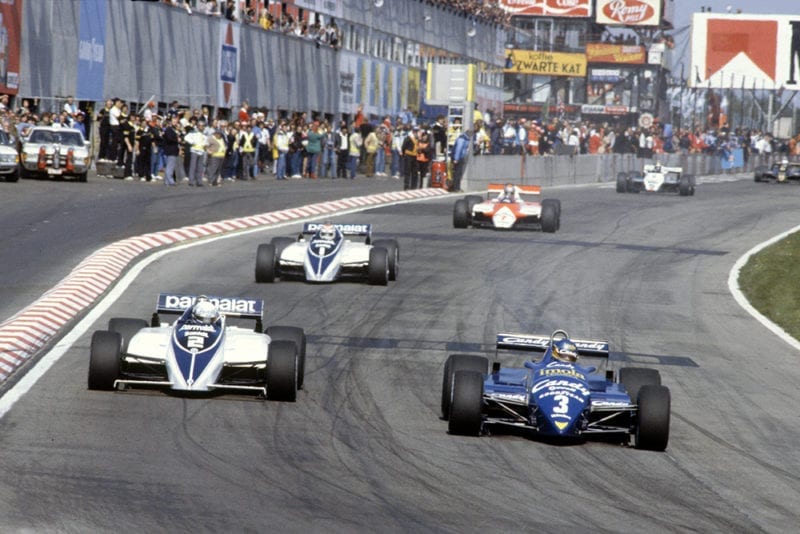
Michele Alboret in his Tyrrell 011-Ford leads Riccardo Patrese (Brabham BT50-BMW), Nelson Piquet (Brabham BT50-BMW), John Watson (McLaren MP4/1B-Ford), Derek Daly (Williams FW08-Ford) and Elio de Angelis (Lotus 91-Ford).
Motorsport Images
Arnoux made two more exploratory laps with no improvement and it was then found that the butterfly spindle on the right-hand compressor had broken, so he only had one throttle valve operating, which accounted for the loss of power. Fabi was in the pits with brake problems and the other Toleman-Hart was still running at the hack of the field, but not making up ground on anyone, unlike Mansell who had been carving his way through the field changing gear without the clutch, but it was all to no avail when the gearbox broke on lap 10. Having got the Renault of Prost out of their hair, Lauda and de Cesaris were closing up on Rosberg, the young Italian with the facial twitch doing a good job to hold on to the wily old ex-World Champion. Prost was having a terrible time, conceding places to Patrese and Watson and rather than concede to Alboreto, he dived into the pits for a change of tyres in the hope of improving things. From total domination of practice and qualifying the Renault effort had dwindled to nothing within a third of the race. As Prost left the scene at the end of 17 laps Rosberg was about to lap the tailenders and Lauda’s superior track craft allowed him to close up still further in the traffic, with de Cesaris shadowing his every move. Watson was close behind Patrese, wondering how he could get by and Piquet was going so badly that Jarier, Cheever and Laffite were keeping pace with him. A disgruntled de Angelis was in the pits for a new set of tyres and Jarier was soon in follow him, whilst Prost was in again to try yet another set, the last lot making very little improvement.
Once clear of the traffic Rosberg pulled away from Lauda, but relative to the Austrian he looked to be driving in desperation. Lauda’s smoothness and finesse really does make a lot of drivers look like rank amateurs. While others slide up over the bevelled kerbs and occasionally raise dust, Lauda always seems to have nearly a foot to spare. Henton called at the Tyrrell pits to say he did not think all was well with his Cosworth engine, but he was sent on his way again. Less than ten laps later there was an almighty bang and a cloud of smoke and an expensive blow up! Only a few laps before, Alboreto’s engine had blown up, after smoking ominously for a lap or two so the Tyrrell team had a big bill to face up to. The Toleman team were packing their bags as Fabi’s brake trouble had proved to be terminal and Warwick retired with a broken drive-shaft.
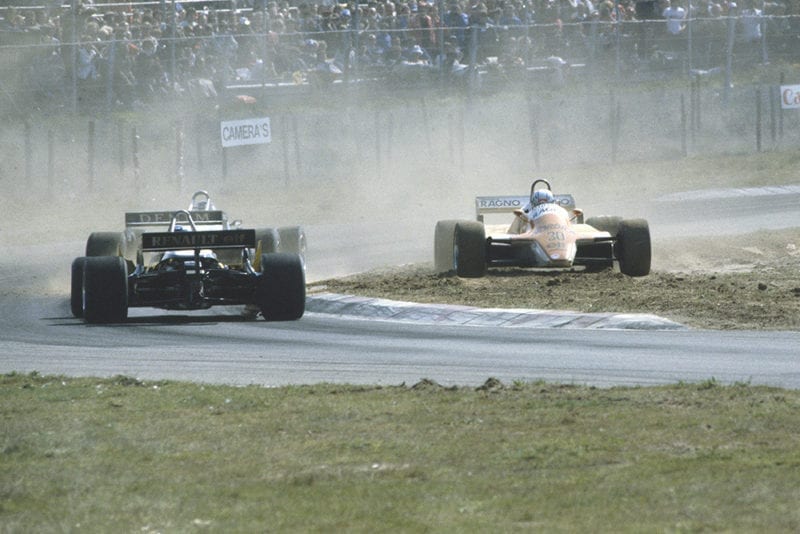
Mauro Baldi (Arrows A4-Ford Cosworth) spins out of the race.
Motorsport Images
As lap 30 began Rosberg had lapped Serra’s Fittipaldi and past the pits and into the first corner Lauda and de Cesaris came up behind the Brazilian driver. He overdid his braking and spun in the middle of the road, which caused Lauda to have to brake exceptionally hard and almost come to a stop. The bright de Cesaris took this opportunity to nip by on the inside and snatch second place and Lauda set off after him while a rather red-faced Serra continued on his way. Almost unnoticed Watson had got past Patrese so the order as half distance approached was Rosberg, still driving hard, de Cesaris, Lauda, Watson, Patrese, Daly, Cheever and Laffite the rest being a lap behind. Piquet had been having trouble with his gearchange and at one point it stuck in gear, resisting all his efforts on the lever.
He headed into the pit lane and as he approached the pits, still struggling with the lever, it freed itself so he drove straight past his puzzled pit staff and rejoined the race. Poor de Cesaris was destined not to reach half-distance as he retired in the pits instead of completing lap 35, his gear change linkage having broken.
This now left Rosberg and Lauda on their own but the McLaren’s tyres were wearing badly and had lost their maximum efficiency so that the Austrian driver was forced to drop back, not only losing contact with the leading Williams but falling prey to his team-mate. For once everything was going right for Watson, his tyres were in fine shape, the car was running well, its handling was good and there was nothing to stop him racing at his limit. In response to pit signals he pressed on while Lauda was slowing and Rosberg was just holding his own but worried about his tyre wear and rather erratic braking. The calculating Lauda decided to settle for third place at the worst, rather than stop for a tyre change and on lap 47 Watson was by into second place, going as well as ever. Jarier shot into the pits for another set of tyres and in his haste to get back into the race, he took off before one of the mechanics had finished tightening a rear wheel. The air line to the pneumatic spanner caught in the rear aerofoil and bent it all out of shape as the Osella went off down the pit lane. The damage was irreparable. Prost was still circulating at the back but suffering violent understeer on left handers, and twice ran on to the sand on the outside of the first corner. It later oversteered on a right hander and spun him out of the race. Laffite had an off-course excursion and tore off the left-hand skirt rubbing-strip which got caught up in the rear suspension, so he lost all hope of keeping up with Cheever and a pit-stop for a new skirt put him right out of the running. Cheever now began to close up on Daly and at 50 laps the order was Rosberg still seemingly unassailable. Watson closing steadily, Lauda holding on to third place, Patrese in fourth place with the only competitive turbo-charged car, Daly in fifth place and Cheever sixth, everyone else being a lap or more behind. Elio de Angelis had lost a lot of time on his tyre change, but was making up ground on the also-rans though not on the leaders. On lap 53 Patrese slid off the road into the catch fences and while marshals were helping him Piquet ran wide, nearly collected the abandoned Brabham and then spun in the middle of the track, but kept the engine going and went on his way.
As the end of the race began to come into sight two things were happening. Kosberg was slowing dramatically as his left rear tyre was badly worn, and Watson was going as fast as ever. Cheever was right behind Daly and looking for a way past. At the start of lap 61 Daly overdid his braking for the first corner and spun off into the catch fences, out of the race, leaving a smiling Eddie Cheever in fourth place now. Patrese’s retirement having let these two move up a place. Watson did not quite have Rosberg in sight, only his pit signals telling him how he was closing up. As he swept into his sixty-first lap he saw the Williams FW08 in the catch fences and assumed it was Rosberg, so he eased right off to coast home to victory. His pit staff soon woke him up again and he rose to the occasion magnificently, setting a new lap record on lap 67 as he zoomed up behind the ailing Williams of Rosberg. The left rear tyre really was in a rough state by now and on the penultimate lap Watson was right on Rosberg’s tail as they came into the hairpin at the far end of the circuit, which is right-handed which means that the left-rear tyre does most of the work. They were both about to lap Surer’s Arrows A4 and Rosberg got into a bit of a twitch as he braked, went too deep and had to lift off and run wide and up the bevelled kerb. “Wattie” was by on the inside in a decisive movement and away into the lead. It was all over.
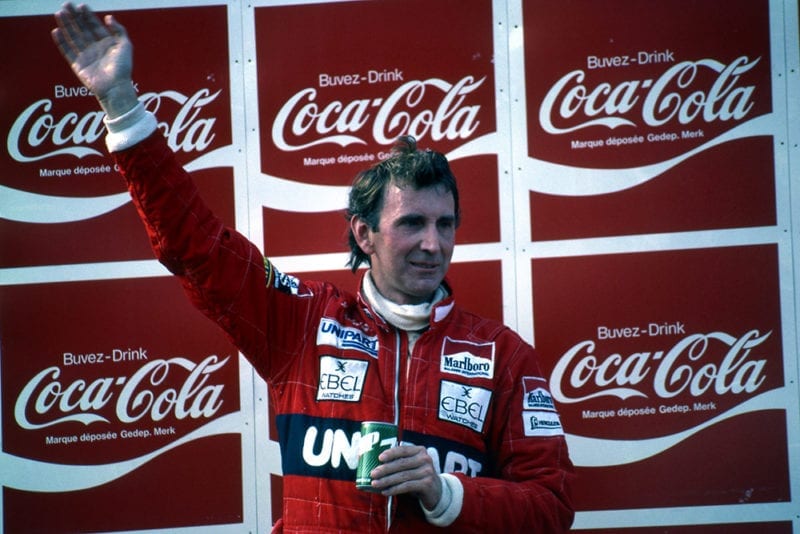
Race winner John Watson on the podium.
Motorsport Images
There were only three cars on the same lap at the end, the wily Lauda pussy-footing home into third place. If he had stopped for new tyres he would have had to battle his way back through the also-rans and could not have gained more than third place even then. Very shrewd is Niki Lauda, a true professional racing driver. So dear old “Wattie” won another race, rather like the way he won the British Grand Prix last year, not front aggression and from the front, but from mid-field just doing an honest job and benefiting from the troubles of others. It could not happen to a nicer bloke.
As the first seven cars finished they were impounded, the petrol drained out and they were weighed. The results were: McLaren (Watson: 581 kgs (whew!), Williams (Rosberg) 591 kgs., McLaren (Lauda) 578 kgs. (oh dear!), Talbot (Cheever) 612 kgs. (cor!), Lotus (de Angelis) 585 kgs., Brabham-BMW (Piquet) 587 kgs. (hmm!), Fittipaldi (Serra) 600 kgs. There was no discussion, poor old Lauda was disqualified from his third place and everyone moved up a place. The shop-steward was still thumbing through the Concorde Agreement, as he had been doing ever since the Renaults dropped out. After all the foreboding nothing happened, but with the death of Gilles Villeneuve Grand Prix racing will not be the same. It will still go on and one day another star will appear and shine brightly, but until that day something has gone out of racing that will be hard to replace. “He shall not grow old . . .”. — D.S.J.
